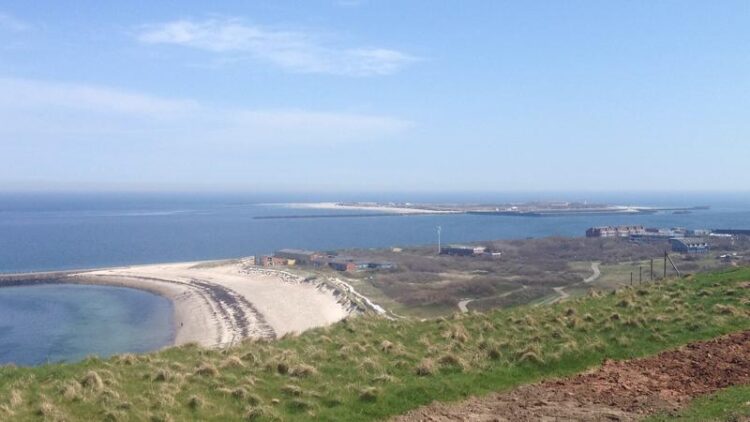Fully booked at the bottom of the sea

There is plenty of sand on the North Sea island of Helgoland. And yet, on the sand-covered seabed, living space for new bacterial species is very limited.
(c) Jan Brüwer
There seems no room for new bacteria on sand grains.
Whether summer or winter, midnight sun or polar night – the sand on the ocean floor is always inhabited by the same bacteria. Although the microbial communities differ between different ocean regions, they do not change between the seasons. Presumably, there is simply no room for change. Researchers at the Max Planck Institute for Marine Microbiology in Bremen, Germany, now describe this phenomenon in a study published in the journal ISME Communications.
A relaxing vacation on the beach frees us from many of the worries of everyday life. But the sand not only cleans the head and soul of vacationers – it also cleans the seawater.
Coastal sands are so-called biocatalytic filters. Hundreds of thousands of bacteria live on each grain of sand, and they process, for example, nitrogen and carbon from the seawater that flows through the sands. In this way, the sands act like giant, purifying filters. Much of what the seawater washes into the ground does not come out again.
A study by researchers at the Max Planck Institute for Marine Microbiology in Bremen, Germany, published in the journal ISME Communications, now shows that the bacteria living on the sand are very different from the ones in seawater. And while the bacterial community in the water is constantly changing and adapting with the changing seasons, the sand bacteria are rather indifferent to spring, summer, fall and winter.
Stable in number and type

(c) Katrin Knittel
The team led by Katrin Knittel and Sebastian Miksch from the Max Planck Institute in Bremen studied the sand bacteria in the North Sea off Helgoland and in the Arctic near Spitsbergen, where there is no primary production at all during the polar night. “Both the number and the type of bacteria were surprisingly stable,” reports Miksch, who conducted the study as part of his doctoral thesis. “Actinobacteria of the orders Actinomarinales and Microtrichales were particularly numerous and also particularly active. They probably play a prominent role in the turnover of organic material in these coastal areas.” While the respective proportions of these two groups differ significantly between the studied sites in Helgoland and Svalbard, in themselves they hardly change.
All booked on the sand grain
“We were very surprised to see such a different pattern in the seafloor than in the water where microbial communities show a pronounced seasonality,” Katrin Knittel explains. The spots on the sand grains that are well-protected from friction and predators are densely populated with bacteria while exposed spots show a low population density. The researchers therefore suspect that there is simply no habitable space for new, different inhabitants. “All the apartments are already occupied, so to speak. New tenants who could change the community simply can’t find a sheltered place – or at least not in large numbers,” Knittel adds.
But do bacteria really not care about the season as well as polar night and day? “We now want to go a step further, and look inside the bacteria. The bacteria remain the same, but over the seasons, perhaps the activity of different enzymes changes because different food arrives at the bottom.”
Wissenschaftliche Ansprechpartner:
Dr. Katrin Knittel
Department of Molecular Ecology
Max Planck Institute for Marine Microbiology, Bremen
Phone: +49 421 2028-9990
E-mail: kknittel@mpi-bremen.de
Dr. Fanni Aspetsberger
Press Officer
Max Planck Institute for Marine Microbiology, Bremen
Phone: +49 421 2028-9470
E-mail: faspetsb@mpi-bremen.de
Originalpublikation:
Sebastian Miksch, Mirja Meiners, Anke Meyerdierks, David Probandt, Gunter Wegener, Jürgen Titschack, Maria A. Jensen, Andreas Ellrott, Rudolf Amann and Katrin Knittel (2021): Bacterial communities in temperate and polar coastal sands are seasonally stable. ISME Communications (published online 28. 06.2021).
DOI: https://doi.org/10.1038/s43705-021-00028-w
Weitere Informationen:
Media Contact
All latest news from the category: Life Sciences and Chemistry
Articles and reports from the Life Sciences and chemistry area deal with applied and basic research into modern biology, chemistry and human medicine.
Valuable information can be found on a range of life sciences fields including bacteriology, biochemistry, bionics, bioinformatics, biophysics, biotechnology, genetics, geobotany, human biology, marine biology, microbiology, molecular biology, cellular biology, zoology, bioinorganic chemistry, microchemistry and environmental chemistry.
Newest articles

Innovative 3D printed scaffolds offer new hope for bone healing
Researchers at the Institute for Bioengineering of Catalonia have developed novel 3D printed PLA-CaP scaffolds that promote blood vessel formation, ensuring better healing and regeneration of bone tissue. Bone is…

The surprising role of gut infection in Alzheimer’s disease
ASU- and Banner Alzheimer’s Institute-led study implicates link between a common virus and the disease, which travels from the gut to the brain and may be a target for antiviral…

Molecular gardening: New enzymes discovered for protein modification pruning
How deubiquitinases USP53 and USP54 cleave long polyubiquitin chains and how the former is linked to liver disease in children. Deubiquitinases (DUBs) are enzymes used by cells to trim protein…



